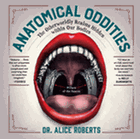
With infectious delight and humor, Alice Roberts (Evolution: The Human Story) discusses structures of the human body in Anatomical Oddities. A full spread is devoted to each of the nearly 60 body parts Roberts addresses, with one page containing text and a small diagram locating the structure on the body, and its facing page containing an illustration drawn by Roberts herself. Readers are drawn into what the subtitle calls the "Otherworldly Realms Hidden Within Our Bodies" through the book's playful tone. And with instructions about where to press fingers to feel bone or how to flex limbs to feel muscle, Roberts invites readers to find these places on their own bodies.
Roberts also discusses the etymologies of medical and colloquial terms, which she often uses to discuss the history of anatomical discovery, including ancient and medieval theories later proven wrong. Many of these etymologies inspire Roberts's illustrations, like one of the thyroid as a Bronze Age shield frieze; she speculates this is the reason the Roman anatomist Galen called this anatomical structure thyreoeides, or "shield-shaped." She also depicts the cauda equina, the bundle of nerve roots at the end of the spinal cord, as a horse's tail. Respect for centuries of anatomical discovery pervade the book, but Roberts is also not above some tongue-in-cheek teasing of the predominantly male early anatomists who applied the term "mammillary" to any structure remotely resembling breasts. Whether read in a single sitting or in bite-sized explorations, this book is sure to delight. --Dainy Bernstein, postdoc in children's literature, University of Illinois Urbana-Champaign

